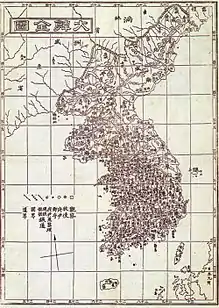Daehanjiji
Daehanjiji (Korean: 대한지지; Hanja: 大韓地誌) is an elementary school geography text about the Korean Empire by Hyeon Chae (Korean: 현채; Hanja: 玄采). Hyeon Chae wrote the book in 1899, translating and compiling Japanese and Korean sources. It was published by Gwangmun-sa (Korean: 광문사; Hanja: 廣文社), Seoul.
.jpg.webp)
Daehanjiji was first published in 1899 and reprinted in 1901. It gave a summary description of late 19th century Korean geography with greater emphasis on physical geography. The written language conformed to the then innovative Gukhanmun Honyongche, one combining han'geul and hanja, and was popular for the relative ease of deciphering.
The titles, authors, and chronologies of source material for the compilation are not always stated, yet Gomatsu Susumu(小松運)'s Chōsenhachidō-shi(朝鮮八道誌; Joseon Paldo-ji, 1887)[1] and Matsumoto Nikichi(Kendo)(松本仁吉; a.k.a. 謙堂)'s Chōsenchishi Yoryaku (朝鮮地誌要略; Joseon Jiji Yoryak, 1894)[2] and their styles are suspected as primary sources and models for emulation.
The author states in the epilogue that he employed several Japanese geographies on Korea, and that he supplemented these with the historical sections from Shinjeung Dongguk Yeojiseungram.[3]
As the first Western-style geography textbook published in late Joseon dynasty, it was part of the Gaehwa policy,[4] the opening up to enlightenment for the Korean masses and raising awareness and unity as a nation by inviting commoners to learn everything they could about the Korean Empire and its landscape, namely the Korean Peninsula at late 19th century. Lee Gyu-hwan (Korean: 이규환; Hanja: 李圭桓), Director of Editorial Office, Ministry of Education, wrote the foreword. Daehanjiji was employed in the school system, but was banned, confiscated, and burned by Protectorate General by Notice No. 72 of Nov. 19, 1910.[5]
Related works

Daehanjiji was the last of the three geographical works of the late 1900s. The provincial gazetteers that were written from 1871 onward, Joseon Jiji (朝鮮地誌; 1895, 1 vol.), and Dahanjiji itself. Its reprinting in 1901 was followed by other geographical works by authors who were inspired by its novelty, yet who were disappointed by its brevity and obvious omissions. Thus were published Daehan Shinjiji (大韓新地志, Jang Jiyeon, 1907), Chodeung Dahanjiji (初等大韓地誌, An Jonghwa, 1907), and again Chodeung Dahanjiji (初等大韓地誌 An Jonghwa, Ryun Yeon, 1908), which described Usan Island as lying to the Southeast of Ulleung Island. As for institutional innovations in the local administrations since the Japanese invasions (1592-1598), down to 1904, the 1908 Jeungbo Munheon Bigo, The Expanded Encyclopedia of the Eastern Nation, succinctly noted the redevelopment of Ulleung Island of 1883, its promotion to Uldo County of 1900, and the incorporation of Usan Island under Uldo County jurisdiction.
Geographical claims
Daehanjiji describes the domain of the Great Korean Empire as stretching from 33°15′N to 42°25′N and from 124°30′E to 130°35′E, which would exclude the Liancourt Rocks (located at 37°14′30″N 131°52′0″E), ownership of which is claimed by both Korea and Japan.[6][7][8]
Although Daehanjiji garnered praise as a pioneering Western-style textbook in late Joseon dynasty, it was criticized for its overt dependence on Japanese geographies. It had borrowed heavily from the Japanese sources in its overview, format, and content material, and its longitude-latitude co-ordinates were literally translated from the Japanese books rather than taking Korean measurements conducted by the Korean government.[9] The so-called four limits of the Korean peninsula, including the eastern limit ~~ that have drawn heavy criticism, have been identified in such prior Japanese geographies as follows.[10]
References
- 朝鮮八道誌 小松運 http://db.mkstudy.com/mksdb/e/korean-geography/book/9836/
- (新編) 朝鮮地誌要略. 松本仁吉(松本謙堂) 1894. http://db.mkstudy.com/mksdb/e/korean-geography/book/9892/
- Gwangmu 3, Dec. 25, Postface: 大韓地誌跋 余所編地誌 本 諸日人所記, 叅 諸輿地勝覽旁 及部府掌 故而其所敍述 略倣, 古山水記, 簡嚴之意少而悠揚之詞多蓋變體也. 舍正體而爲變體 者奈何 余以爲今便 小學童子課習地誌, 而其文簡湥(淚의 오자?)一如禹貢水經之 爲則其不便有四, 難讀一也, 難記一也, 難欽動一也, 難開發一也, 以此四 難望其成功不亦迂乎! 故余之爲此也. 要使難易適得相半難不至太蕀 而不至太俚渙然冰釋怡然理順俱其名勝. 敍述本出於日人一時遊歷 之際其於山脈水脈或不能無失之病 而顧以敎課事急不能磨歲月 博考腒此 其所愧也. 世之君子其或蹋而輯之匡余過誤而歸于至當則 斯厚幸云 光武三年十二月二十五日 白堂 玄采跋
- For the Gaehwa policy, see "개화 정책 Enlightenment policy". Encyclopedia of Korean culture (in Korean). Retrieved 2023-08-03.
- 조선총독부관보제69호고시제72호(官報:1910년 11월 19일), http://pds11.egloos.com/pds/200812/27/11/b0016211_495594980fcd7.jpg
- Korea's MOFA(外交部)(1977), 「Japanese Memo. 2」(1954. 2. 10), 『Dokdo Documents 1(獨島關係資料集1)-Memoranda(往復外交文書)(1952~1976) -』, p. 57
- Shimojo Masao (下條正男)(1998. 8), 「Dokdo Issues」, 『Han'guk Nondan(韓國論壇)』 pp. 108, 132~152; (2007. 9), 「Behold, ye historical revisionists of Japanese territory 「Takeshima」(日本の領土「竹島」の歷史を改竄せし者たちよ)」, 『Shokun!(諸君!)』, Bungeishunjū-sha(文藝春秋社); "Takeshima(KoreanㆍDokdo), whose is it, Korean or Japanese"(2004, Bungeishunjū-sha, p. 115)
- Muzuma Masanori(水間政憲, 2012) "1899 Korean textbook proving ‘No Dokdo within Korea’ found" (「1899年発行の韓国の教科書に『竹島は韓国領でない』証拠発見」Japanese news article) http://www.news-postseven.com/archives/20121015_149188.html
- 윤소영(2013). 근대 일본 관찬 사찬 지리서에 나타난 독도 인식. 한국독립운동사연구소 월례발표회 292. p. 19
- Hosaka Yuji
- 환영수로지(寰瀛水路誌; 海軍水路部 嘉納謙作; Kanō Kensaku, Japanese Navy's Hydrographic Office, 1883), http://mblogthumb2.phinf.naver.net/20140421_157/kskimpak_1398081500975MX4UE_JPEG/%C8%AF%BF%B5%BC%F6%B7%CE%C1%F6.jpg?type=w2
- 환영수로지(寰瀛水路誌; Kan’ei Suiroshi, 海軍水路部 嘉納謙作; Kanō Kensaku, Japanese Navy's Hydrographic Office, 1886), http://dl.ndl.go.jp/info:ndljp/pid/1084068/17
- 조선팔도지(朝鮮八道誌; Chōsenhachidō-shi, 小松運; Gomatsu Susumu, 1887), http://dl.ndl.go.jp/info:ndljp/pid/766919/10
- 신찬조선국지도(新撰朝鮮国地図; Shinsen Chōsenkoku Chizu, 林正; Hayashi Tadashi, 1894.7) http://dl.ndl.go.jp/info:ndljp/pid/767582/7
- 신찬조선지리지(新撰朝鮮地理誌; Shinsen Chōsen Chiri-shi, 大田才次郎; Ota Saijiro, 1894), http://www.tanaka-kunitaka.net/takeshima/chosenchirishi-1894/08.jpg Archived 2016-09-15 at the Wayback Machine
- 조선수로지(朝鮮水路誌; Chōsen Suiroshi, 海軍水路寮; Japanese Navy's Hydrographic Office, 1894.11) http://www.geocities.jp/tanaka_kunitaka/takeshima/hydrograph1894/1894-3s.jpg